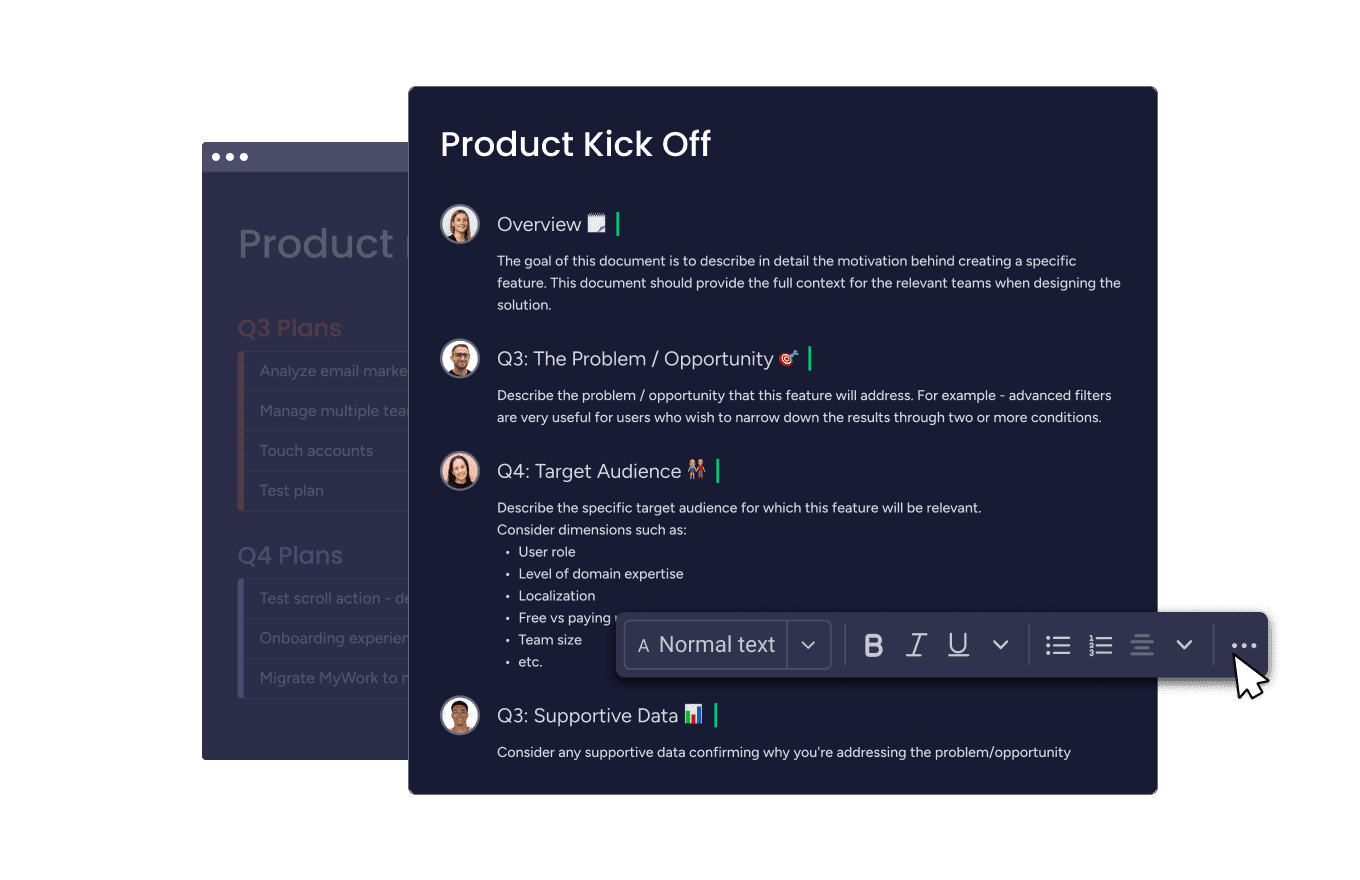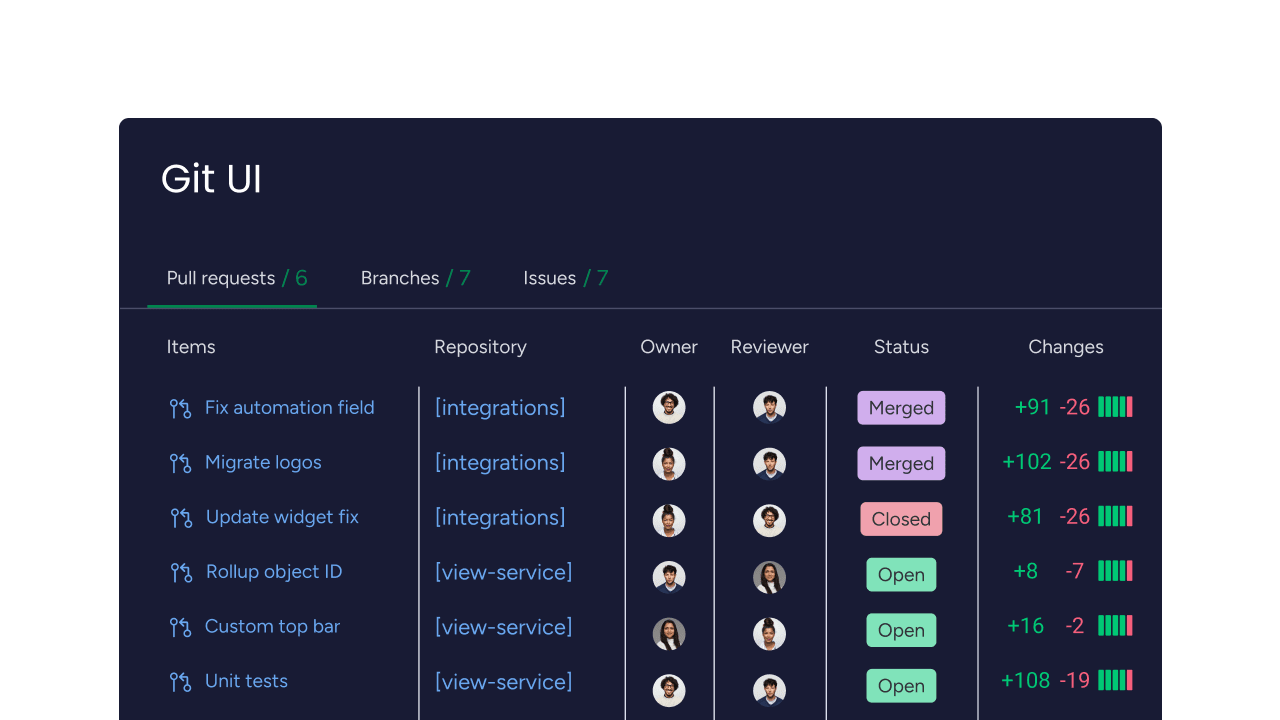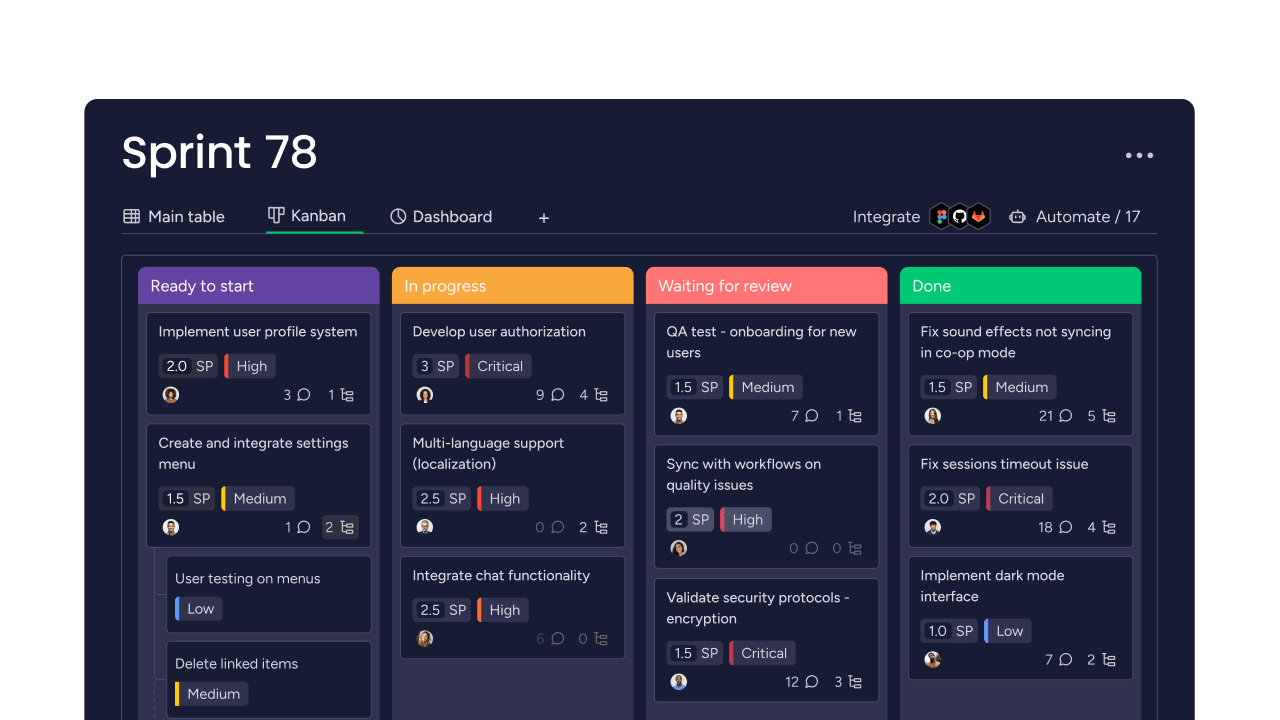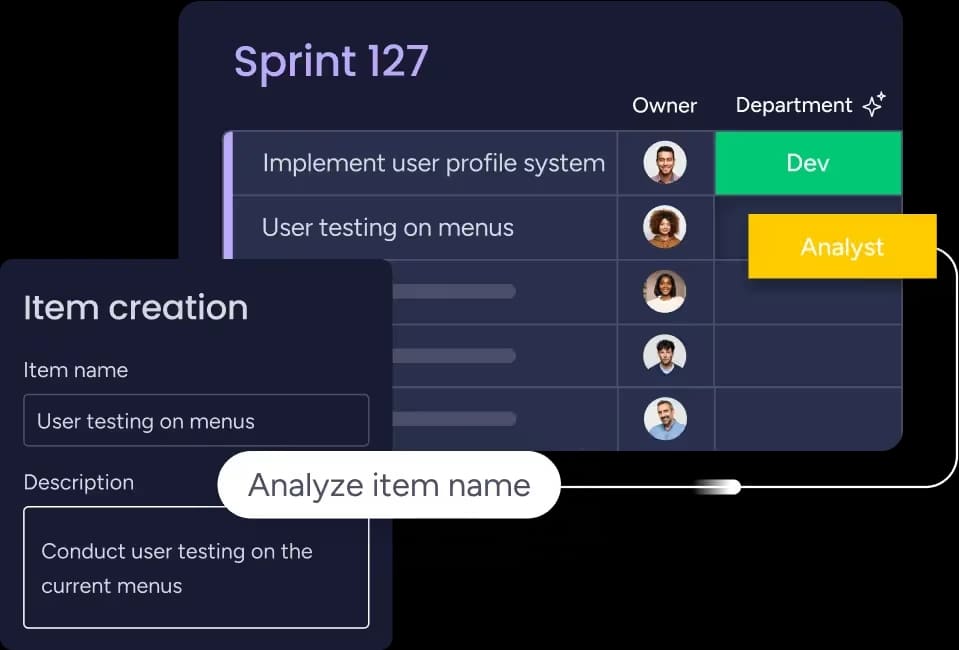Modern development teams are under constant pressure to deliver more, faster. But speed without alignment only creates chaos: projects stall, priorities shift, and collaboration breaks down. Real progress happens when teams move quickly and in the same direction.
Agile software development gives teams the structure to do exactly that. Built on collaboration, flexibility, and short, iterative cycles, it turns big goals into steady, measurable progress. Each sprint delivers tangible value, helping teams adapt to feedback and stay focused on what matters most.
This article explores how Agile works in practice — its core principles, defining methodologies, and the proven habits of teams that use it in 2025 to plan smarter, ship faster, and build with confidence.
Key takeaways
- Faster delivery: Agile development produces working software in short one to four week cycles, helping teams adapt quickly to changing requirements and feedback.
- Strategic adoption: begin your Agile transformation with a focused pilot project and leadership support to reduce risk and build confidence across the organization.
- Outcome-driven focus: measure success by business impact such as customer satisfaction, product adoption, and value delivered rather than activity-based metrics.
- Streamlined visibility: monday dev supports every Agile framework with customizable workflows, automation, and AI-powered insights that keep teams aligned and moving faster.
- Sustainable rhythm: practices like daily standups, sprint planning, and retrospectives help teams stay connected, continuously improve, and maintain steady delivery.
What is Agile software development?
Agile software development is an iterative approach to building software that emphasizes flexibility, collaboration, and customer feedback. Among software development methodologies, it has become an industry standard, with around 97% of organizations now using Agile methods to some extent. This means teams work in short cycles called “sprints” (typically one to four weeks) delivering working software incrementally rather than waiting months for a complete product.
The core idea is simple: instead of planning everything upfront and following a rigid plan, you adapt as you learn. Teams break large projects into smaller, manageable pieces and gather feedback after each iteration, a process that aligns with Agile planning.
What are the 4 core values of Agile?
The Agile Manifesto defines four core principles that shape how teams plan, build, and deliver software. These Agile values
guide everyday decisions, helping teams prioritize collaboration, adaptability, and customer value:
- Individuals and interactions over processes and tools: focus on empowering people to communicate and collaborate effectively rather than relying on rigid procedures.
- Working software over comprehensive documentation: prioritize delivering functional software that users can interact with instead of spending months on detailed specifications.
- Customer collaboration over contract negotiation: engage with customers throughout development to ensure solutions meet real needs rather than defining every detail upfront.
- Responding to change over following a plan: treat new requirements as opportunities to deliver more value instead of resisting them.
Together, these values form the foundation of the Agile mindset. The next step is understanding how they translate into action through the 12 essential principles of Agile development.
12 essential principles of Agile development
Building on the Agile values we touched on above, the 12 principles of Agile development turn those ideas into practical habits teams can apply every day. These Agile principles shape how software is planned, built, and improved while keeping customer value at the center of every decision:
- Customer satisfaction through early delivery: release valuable software frequently to provide continuous improvement and faster results.
- Welcome changing requirements: use change as a competitive advantage, even when it happens late in development.
- Deliver working software frequently: focus on short, consistent cycles that turn plans into usable products.
- Business and development collaboration: maintain close, daily cooperation between technical and business teams.
- Motivated individuals: build projects around empowered people and trust them to deliver high-quality results.
- Face-to-face conversation: prioritize direct communication as the most effective way to share ideas and solve problems.
- Working software as progress measure: measure success by functional software rather than documentation or process completion.
- Sustainable development pace: maintain a steady rhythm that teams can sustain long-term without burnout.
- Technical excellence: emphasize strong design and clean code to make future changes faster and easier.
- Simplicity: focus on what truly matters and minimize unnecessary work.
- Self-organizing teams: allow teams to determine how best to achieve their goals for maximum ownership and creativity.
- Regular reflection: hold retrospectives to identify opportunities for continuous improvement.
These principles bring Agile values to life, creating a framework where teams can move quickly, adapt confidently, and deliver meaningful results.
Agile vs Waterfall: key differences that matter
While both Agile and Waterfall aim to deliver quality software, they take very different paths to get there. Waterfall follows a linear, step-by-step process where each phase — from planning to deployment — must finish before the next begins. It works best for projects with fixed requirements and little room for change.
Agile, on the other hand, embraces flexibility. Teams work in short, iterative cycles, delivering working software early and refining it through continuous feedback. This approach keeps projects adaptable and aligned with evolving customer needs.
The table below highlights how Agile and Waterfall differ across some of the most important aspects of software development.
| Aspect | Agile | Waterfall |
|---|---|---|
| Approach | Iterative cycles | Sequential phases |
| Timeline | 1-4 week sprints | Months-long phases |
| Flexibility | Embraces change | Resists change |
| Customer involvement | Continuous | Beginning and end only |
| Risk management | Early detection | Late discovery |
When to use Agile methodology
- Customer needs evolve based on market conditions.
- You’re solving complex problems without clear solutions.
- Quick delivery provides competitive advantage.
- Close stakeholder collaboration is possible.
When Waterfall still makes sense
- Requirements are well-defined and unlikely to change.
- Compliance requires extensive documentation.
- Budget and timeline are fixed with no flexibility.
- Technology and approach are well-understood.
The Agile development process: 6 key steps
The Agile development process follows a repeating cycle where teams move through six key steps during each iteration. This Agile SDLC approach allows continuous improvement while building software incrementally.
Step 1: Gather requirements collaboratively
Work with stakeholders to identify features for the upcoming sprint. Focus on understanding immediate needs rather than defining everything upfront.
Product owners and developers discuss acceptance criteria together. This collaboration ensures everyone understands what success looks like before work begins.
Step 2: Plan sprints and iterations
Estimate effort for each user story and commit to realistic work for the iteration. This is part of Agile release planning to keep sprints aligned with long-term goals. Break down stories into specific work items and identify dependencies.
Consider your team’s velocity from previous sprints. This helps set achievable goals and builds stakeholder trust through reliable delivery.
Step 3: Develop in short cycles
Begin building with focus on delivering working software within the sprint timeframe. Developers collaborate through pair programming and code reviews.
Daily stand-ups keep everyone aligned. These brief meetings help identify blockers early and adjust plans as needed.
Step 4: Test continuously
Testing happens throughout development, not just at the end. Teams use automated testing, manual testing, and user acceptance testing to ensure quality, illustrating Agile testing practices.
Continuous testing provides rapid feedback. This approach catches issues early before they become expensive problems.
Step 5: Deploy incrementally
Release working software at each iteration’s end. This gives stakeholders tangible progress they can evaluate and use.
Automated deployment pipelines ensure smooth releases. Real users provide feedback that shapes future iterations.
Step 6: Review and adapt
Conduct retrospectives to identify what worked and what needs improvement. Sprint reviews gather stakeholder feedback on delivered functionality.
Use these insights to refine your approach. Each iteration makes your team more effective at delivering value.
5 most effective Agile methodologies
Agile is not a single method but a collection of approaches that bring its principles to life in different ways. Each methodology provides structure for how teams plan, collaborate, and deliver work while staying flexible enough to adapt as priorities shift.
Choosing the right framework depends on your team’s goals, workflow, and culture. Some emphasize speed and adaptability, while others focus on technical precision or continuous flow. Understanding the key differences helps teams select the approach that aligns best with how they work.
Below are five of the most widely adopted Agile methodologies that drive efficiency, collaboration, and consistent delivery.
1. Scrum framework
Scrum organizes work into fixed-length sprints with Agile roles like Product Owner, Scrum Master, and Development Team. Regular ceremonies include sprint planning, daily stand-ups, reviews, and retrospectives.
This structure provides clarity while maintaining flexibility. Agile vs Scrum comparisons highlight how Scrum works well for teams delivering complex products in uncertain environments.
2. Kanban method
Kanban visualizes workflow using boards with columns for different work stages. Teams pull work based on capacity rather than working in fixed iterations.
Work-in-progress (WIP) limits prevent overload and highlight bottlenecks. Kanban suits teams with steady work streams or those transitioning from traditional approaches.
3. Extreme programming (XP)
Extreme programming (XP) emphasizes technical practices like pair programming, test-driven development, and continuous integration. These practices improve code quality while delivering value quickly.
Teams using XP focus on technical excellence and close customer collaboration. It’s ideal for teams prioritizing software craftsmanship.
4. Lean software development
Lean applies manufacturing principles to eliminate waste and optimize value delivery. Key practices include deciding as late as possible and empowering teams.
This approach works for organizations seeking to optimize their entire development process. Lean thinking helps identify and remove inefficiencies systematically.
5. Feature-driven development (FDD)
FDD organizes work around delivering specific features through short iterations. The methodology includes five processes from modelling to building by feature.
This approach suits larger teams working on complex systems. Feature-based organization provides clarity for stakeholders and developers alike.
Benefits of Agile software development for modern teams
Agile delivers measurable results that strengthen an organization’s ability to move fast, stay aligned, and compete effectively. As teams mature in their practices, these benefits compound and create lasting impact.
The most recognized advantages include faster time to market and higher customer satisfaction. Research shows that organizations scaling Agile can achieve up to a 30% improvement
in customer satisfaction and cut time to market by nearly half — giving them the agility to seize new opportunities quickly.
Teams also become more engaged and productive by self-organizing around shared goals. Continuous testing and integration lead to better software quality, while the built-in flexibility of Agile enables teams to adapt confidently when markets, technologies, or priorities shift.

How Agile works with AI and modern development platforms
Artificial intelligence is reshaping how Agile teams plan, build, and deliver software. With most IT professionals already integrating AI into their workflows, its role in development is rapidly shifting from experimental to essential.
AI does not replace Agile principles — it amplifies them. By analyzing data, automating repetitive tasks, and surfacing actionable insights, AI helps teams make smarter decisions, improve accuracy, and maintain the speed Agile demands.
Modern development platforms now use AI to enhance every stage of the Agile cycle, from planning and estimation to testing and continuous improvement. The result is a more efficient, informed, and adaptive way of building software that keeps pace with today’s complexity.
AI-enhanced sprint planning
AI analyzes your sprint history to suggest realistic commitments. Machine learning identifies patterns that humans might miss, predicting which stories might encounter delays.
Automated estimation compares new work to completed stories. This reduces planning time while improving accuracy.
Automated testing integration
Continuous integration pipelines run comprehensive tests automatically. AI-powered platforms generate test cases and identify edge cases you might overlook.
This automation maintains quality without slowing delivery. Teams focus on building features while AI handles routine testing.
Real-time development analytics
Dashboards track velocity, cycle time, and quality metrics automatically. AI surfaces insights about team performance and process bottlenecks.
These analytics inform decisions about process improvements. You spot trends early and adjust before problems impact delivery.
Core Agile practices every team should master
Successful Agile implementation depends on mastering fundamental practices. These create an Agile workflow environment where teams deliver value consistently while adapting to change.
Daily stand-up meetings
Stand-ups provide regular coordination in 15 minutes or less. Team members share yesterday’s progress, today’s plans, and any blockers.
Keep meetings focused on coordination, not detailed reporting. This daily rhythm maintains alignment without creating overhead.
Sprint planning sessions
Planning establishes clear goals for upcoming iterations. Teams review backlogs, estimate effort, and commit to achievable work.
Balance ambition with realism. Good planning creates shared understanding while maintaining sustainable pace.
Retrospective reviews
Retrospectives create space for reflection and improvement. Teams discuss successes, challenges, and specific actions for enhancement.
Regular retrospectives drive continuous improvement. Small adjustments compound into significant gains over time.
Pair programming
Two developers work together on code, with one writing while the other reviews. This collaboration improves quality and spreads knowledge.
Rotating pairs maximizes learning across your team. The practice aligns perfectly with Agile values of collaboration.
Continuous integration and deployment
Automated systems merge code and run tests continuously. Deployment automation reduces manual effort and human error.
These practices enable frequent delivery while maintaining quality. Teams ship confidently knowing automated checks catch issues early.
7 steps to implement Agile in your organization
Successful Agile implementation requires systematic change addressing both practices and culture, often referred to as an Agile transformation. These steps help you transform sustainably while avoiding common pitfalls.
Step 1: Evaluate your current development process
Document existing workflows, cycle times, and quality metrics. Gather feedback from teams and stakeholders about current challenges.
This baseline helps measure progress and identify priority areas for improvement.
Step 2: Secure leadership support and buy-in
Leadership alignment is critical for lasting Agile transformation. When executives understand the value and model new behaviors, teams follow with confidence.
- Educate leaders: explain how Agile drives faster delivery, adaptability, and business impact.
- Gain commitment: ensure leaders provide resources and remove roadblocks.
- Model change: encourage visible support and consistent communication throughout the transition.
Strong leadership buy-in keeps momentum steady, even when challenges arise.
Step 3: Choose your Agile framework
Selecting the right framework ensures your Agile adoption fits your team and culture.
- Assess your context: consider project complexity, team size, and regulatory needs.
- Start focused: begin with one framework such as Scrum or Kanban to build consistency.
- Adapt as you grow: evolve your approach as your team gains experience and confidence.
A flexible mindset helps teams find the balance between structure and agility.
Step 4: Train your development teams
Provide comprehensive training on principles and practices. Include hands-on workshops where teams practice new approaches.
Effective training addresses both technical skills and collaboration capabilities teams need for success.
Step 5: Launch a pilot project
Choose a small, representative project for initial implementation. Select engaged stakeholders and clear success criteria.
Pilot projects generate lessons while minimizing risk. Success builds confidence for broader adoption.
Step 6: Scale Agile practices across teams
Expand gradually based on pilot learnings. Provide ongoing coaching as teams adapt practices to their contexts.
Pay attention to coordination between teams and shared standards. Scale iteratively with regular assessment.
Step 7: Refine and optimize continuously
Establish mechanisms for ongoing improvement. Regular assessment and adjustment ensure continued progress toward goals.
Continuous refinement reflects Agile principles. Organizations embracing ongoing improvement see sustained benefits.

How to measure Agile success with modern metrics
True Agile success is measured by the value delivered, not just the work completed. The right Agile metrics
help teams track progress, identify improvements, and align development with business outcomes. They focus on outcomes rather than adherence to rigid plans.
Modern platforms like monday dev make this process seamless by turning project data into real-time insights. Built-in analytics dashboards automatically visualize progress, helping teams measure what truly matters: customer impact, team performance, and long-term product health.
Customer satisfaction and feedback scores
Track satisfaction through surveys and net promoter scores. Regular feedback ensures development aligns with user needs.
This direct measurement validates whether Agile practices deliver intended value.
Team velocity and delivery predictability
Measure story points completed per iteration to understand capacity. Velocity trends reveal process improvements and planning accuracy.
Predictability builds stakeholder trust through reliable delivery patterns.
Business value and feature adoption
Monitor user adoption rates and revenue impact of delivered features. Connect development work directly to organizational goals.
These metrics inform future prioritization decisions based on actual value delivered.
Code quality and technical health metrics
Track defect rates, code coverage, and technical debt levels. Balance speed with long-term maintainability.
Technical health metrics provide early warnings, supporting sustainable development pace.
Common Agile challenges and practical solutions
Even well-intentioned Agile initiatives can stumble without the right foundations. Teams often face recurring challenges — from unclear priorities to limited stakeholder input — that slow progress and create frustration.
Understanding these obstacles early helps you address them proactively and keep your Agile transformation on track. The following solutions outline how teams can stay aligned, maintain momentum, and continuously improve.
Unclear product vision and priorities
Vague vision leads to confusion and wasted effort. Teams need clear direction to make daily decisions effectively.
- Solution: hold regular vision sessions with stakeholders.
- Use visible roadmaps: platforms like monday dev maintain transparent priorities.
- Create clear criteria: document how you make prioritization decisions.
Limited stakeholder involvement and feedback
Agile depends on regular stakeholder engagement. Busy stakeholders may struggle to provide timely input.
- Structure feedback cycles: set clear expectations with minimal time commitment.
- Enable asynchronous input: use collaborative platforms for flexible participation.
- Schedule focused sessions: respect stakeholder time while ensuring necessary involvement.
Sprint overcommitment and unrealistic planning
Teams often commit to more than they can deliver. This creates stress and reduces quality.
- Use historical data: base commitments on actual velocity.
- Build in buffer time: account for unexpected challenges.
- Learn from retrospectives: continuously improve estimation accuracy.
Accumulating technical debt over time
Delivery pressure leads to shortcuts that slow future development. Technical debt compounds if ignored.
- Allocate refactoring time: include debt reduction in every sprint.
- Make impact visible: track and communicate technical debt metrics.
- Maintain standards: establish clear quality expectations.

Current Agile trends and exploring future direction
Agile is no longer limited to small software teams, it has become a core approach for how entire organizations plan, build, and adapt. As companies scale and technology evolves, Agile continues to grow in sophistication, embracing automation, AI, and data-driven decision-making.
The latest trends highlight how Agile is maturing across industries, helping teams stay connected, deliver faster, and measure success through real business impact.
AI integration in Agile workflows
AI supports Agile through automated testing, intelligent prioritization, and predictive analytics. Machine learning analyzes patterns to suggest improvements before issues impact delivery.
These capabilities enhance human decision-making while maintaining Agile values of collaboration.
Remote and distributed team collaboration
Digital platforms enable effective Agile across distributed teams. Virtual ceremonies often prove more inclusive than traditional approaches.
Teams develop new practices optimized for remote work while preserving Agile principles.
Value-based development metrics
Organizations shift focus from activity measures to business outcomes. This maturation reflects deeper understanding of what drives success.
Value metrics help teams optimize for customer satisfaction rather than output.
Enterprise-scale agility frameworks
Large organizations extend Agile beyond individual teams. Frameworks address coordination while preserving team autonomy.
The challenge remains balancing alignment with agility at scale.
Transform your Agile practice with monday dev
Sustaining Agile success requires more than principles and processes: it takes the right tools to turn them into everyday habits. That’s where monday dev can add real value. Built on the monday.com Work OS, it gives teams the flexibility to apply Agile their way while staying aligned, transparent, and adaptable.
From sprint planning and automation to analytics and collaboration, monday dev brings every part of your Agile workflow into one connected space. It empowers teams to plan confidently, communicate clearly, and continuously improve (all while maintaining the agility that drives real results)’.
Customizable workflows for any Agile framework
Create workflows matching your specific Agile implementation with ready-made templates for Scrum, Kanban, and SAFe. Drag-and-drop automation builders let you configure sprint transitions, status updates, and notifications without coding.
Teams evolve their practices while maintaining consistency across projects using dynamic fields that adapt as your process matures.
Complete team visibility and collaboration
Visibility and communication are at the heart of effective Agile teamwork. monday dev brings everything together so teams can stay aligned, informed, and focused throughout each sprint.
- Track progress in real time: view sprint status, blockers, and deliverables through dynamic dashboards featuring burndown charts and velocity widgets.
- Collaborate seamlessly: use @mentions, comments, and the Slack integration to keep discussions organized and priorities clear.
- Centralize knowledge: store documentation, decisions, and code snippets in one searchable hub that supports both synchronous and asynchronous collaboration
AI-powered development insights and analytics
AI categorizes work automatically, predicts sprint completion with dev-specific forecasting, and identifies bottlenecks through code integration analytics. Built-in dashboards reveal velocity patterns and optimization opportunities with customizable widgets for cycle time and lead time.
The monday dev AI assistant helps teams focus on high-value activities by generating user stories, summarizing technical discussions, and suggesting task assignments based on team capacity and expertise.

Frequently asked questions
What is the difference between Agile and Scrum methodologies?
The main difference between Agile and Scrum is that Agile is an umbrella term for flexible development approaches, while Scrum is a specific framework for implementing Agile principles. Agile emphasizes collaboration and customer feedback, and Scrum provides structure for those values through defined roles, ceremonies, and time-boxed sprints. Scrum provides structure for Agile values through practices like sprint planning and retrospectives.
How long does Agile transformation typically take for organizations?
Agile transformation typically takes 12-24 months for organizations to see significant results, though individual teams may adopt practices more quickly. The timeline really depends on organizational size, existing culture, leadership support, and scope of required changes.
Can Agile methodology work effectively for large enterprise organizations?
Yes, Agile works effectively for large enterprises through scaled frameworks like SAFe or LeSS that maintain Agile principles while providing necessary coordination. Success requires strong leadership commitment, cultural change management, and platforms supporting distributed collaboration.
Is Agile development limited to software projects only?
No, Agile development applies successfully to marketing campaigns, product development, research projects, and other knowledge work where requirements evolve and rapid feedback adds value. The principles of collaboration and iteration work broadly beyond software.
How do you calculate the return on investment of Agile implementation?
Calculate Agile ROI by measuring improvements in time-to-market, customer satisfaction, team productivity, and defect reduction against costs of training, platforms, and organizational change. Organizations typically see positive returns within 12-18 months through faster delivery and higher quality.
What development platforms are essential for Agile teams?
Essential platforms for Agile teams include project management platforms like monday dev for workflow coordination, version control systems for code management, continuous integration platforms for automated testing, and communication platforms for collaboration. Specific combinations depend on team size and project complexity.
 Get started
Get started 


